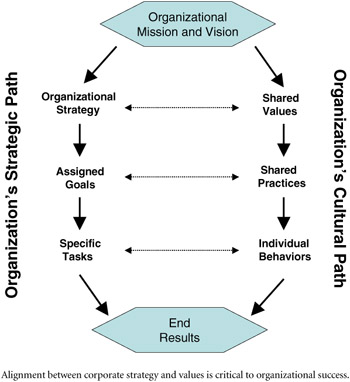Aligning Culture and Business
As you define your core objectives, keep the culture in mind. The culture will either help or hinder the accomplishment of the required objectives. Your core objectives must be aligned with the company's values and business strategies because organizations whose values are aligned with their strategies tend to achieve outstanding results, while those that lack this alignment consistently fall short. The best strategic planning in the world will not lead to performance enhancement if your organization's strategies and corporate culture are not in alignment.
The organizational-alignment model depicted in Figure 3-1 shows the importance of balancing your culture with your business objectives. For example, if as you develop your core objectives you focus only on the left (strategic) side of the model and if there is little congruence between the left and right sides, your initiative will stagnate. In contrast, if you focus only on the right (cultural) side, you'll be liked by all but will have little impact on business objectives or long- term results.

Figure 3-1: Organizational Alignment Model.
This model helps organizations understand many of the complex elements that interact as they undergo significant change. It clearly suggests that paying attention to both the strategic (left side) and the cultural (right side) will determine the relative success of any organization. Congruence between a company's strategy and its intrinsic values, and between its goals and the work practices of its managers, will be the greatest determinant of your success.
Mission and vision are an expression of an organization's fundamental intent. Mission statements define what an organization is in business to do. A vision statement is a statement of some ”usually unattainable ”future state. It is a statement of the impact an organization would have on its environment (customers, shareholders, regulators, and so on) if it successfully completed its mission.
Strategy is a blueprint for the deployment of the organization's resources, including capital, people, time, and energy. It is a clear statement about how the organization intends to proceed.
Goals are at the heart of that strategy. They are the signposts that tell members of an organization when they are achieving strategic imperatives. They are the what, not the how, of organizational performance. Practices, on the other hand, are the typical manner in which employees of the organization interact with one another, customers, regulators, and any other vested group .
Tasks and behaviors are the day-to-day things that truly determine success or failure within a company. Often, tasks are self-directed, and if individuals choose to spend their time on effective activities, the company will prosper . This is where the axiom that leaders do the right things and managers do things right can be observed on a daily basis. Research has shown that in today's environment, an organization that has too many managers and not enough leaders will also have mediocre financial performance.
Finally, the influencers shown at the bottom of the model are important but often-uncontrollable elements that affect how a company ultimately performs . Only internal support systems are controlled by the organization. Outside support systems can play a significant role, as can the business environment, stakeholders or shareholders, and regulators.
Aligning an organization's strategy with its values and its objectives with management practices will determine how well employees perform. This in turn will determine an organization's ultimate success.
EAN: 2147483647
Pages: 124